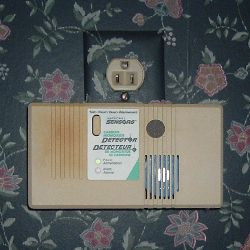Power supply
The devices can either be battery-operated or AC powered (with or without a battery backup). Battery lifetimes have been increasing as the technology has developed and certain battery powered devices now advertise a battery lifetime of over 6 years. All CO detectors have "test" buttons like smoke detectors.
Installation
As CO is slightly heavier than air detectors should be installed near the floor and close to the bedrooms |
|
.
|
| Carbon Monoxide (CO) Detectors |
|
| ...... |
Need more information? Use our search box
Carbon Monoxide (CO) Detectors.
A carbon monoxide detector or CO detector is a device that detects the presence of the carbon monoxide (CO) gas in order to prevent carbon monoxide poisoning. CO is a colorless and odorless compound produced by incomplete combustion. It is often referred to as the "silent killer" because it is virtually undetectable without using detection technology.[1] Elevated levels of CO can be dangerous to humans depending on the amount present and length of exposure. Smaller concentrations can be harmful over longer periods of time while increasing concentrations require diminishing exposure times to be harmful.
CO detectors are designed to measure CO levels over time and sound an alarm before dangerous levels of CO accumulate in an environment, giving people adequate warning to safely ventilate the area or evacuate. Some system-connected detectors also alert a monitoring service that can dispatch emergency services if necessary.
While CO detectors do not serve as smoke detectors and vice versa, dual smoke/CO detectors are also sold. Smoke detectors detect the smoke generated by flaming or smoldering fires, whereas CO detectors go into alarm and warn people about dangerous CO buildup caused, for example, by a malfunctioning fuel-burning device. In the home, some common sources of CO include open flames, space heaters, water heaters, furnaces, blocked chimneys or running a car inside a garage. |
 |
|
|
|